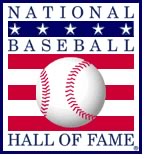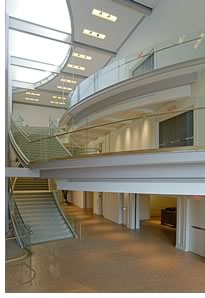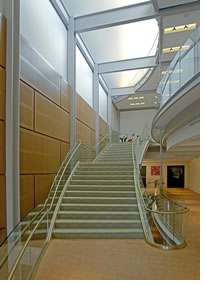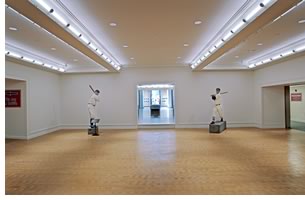

08/2005
Baseball Hall of Fame undergoes major league reconstruction
 by Tracy Ostroff
by Tracy Ostroff
Cooperstown, N.Y., rededicated its revered National Baseball Hall of Fame and Museum July 29, after a two-year, $20-million reconstruction overseen by H3 Hardy Collaboration Architecture’s principal Hugh Hardy, FAIA, with H3’s Jack Martin, AIA; Mario Censullo, AIA; and Jonathan Strauss. Mindful of the treasures and traditions contained within, the architects transformed the site’s seven buildings into a single facility that gained 10,000 square feet of exhibit space for 35,000 artifacts of the national pastime.
“Once you’re in the main stair lobby it really feels like you are in a special place,” says H3’s Censullo. And for many people it is a reflection of the reverence they feel for the institution, exhibits, and especially for the plaque gallery. “As you walk into the lobby you have a picture view of the plaque gallery, so that builds the anticipation of getting toward your destination.” Censullo says the architects “reclaimed” an area for the grand stair entry between the original gymnasium for Cooperstown, built around 1910, and a small building next to it. “Over the years they’ve added space, they’ve expanded, but that space between the two buildings still remained. We filled in that space. And it became the main vertical circulation between the three levels. If you look to the left, there is a stone building with a large roof that ties into the brick building. It looks like it’s always been there, but it’s actually the new part.”
 “[With the grand staircase], we tried to create the feeling that
you’re part of a stadium or ballpark from the past, without duplicating,
without being historicists, and without mimicry,” Censullo says. “We
wanted to get a sense of feeling that you’re part of that history.”
“[With the grand staircase], we tried to create the feeling that
you’re part of a stadium or ballpark from the past, without duplicating,
without being historicists, and without mimicry,” Censullo says. “We
wanted to get a sense of feeling that you’re part of that history.”
Timeline orients fans and baseball history
The architect’s renovation gave the Baseball Hall of Fame and its
curatorial staff the opportunity to redesign the timeline that anchors
an important feature. The visitor can “tie into the history of
baseball in one walkthrough on one level in a linear pathway,” Censullo
says.
With the 2004 World Series Championship Boston Red Sox fans streaming in from the Northeast, for this year in particular, it’s a big thing for visitors to drive to the site. “We all felt there needed to be a space where people can decompress, relax, and get a preview of the plaque gallery,” Censullo says. Arriving visitors get that first glimpse through the lobby’s airy glass panels, a great change from the dark facility that previously greeted families of road warriors. The design offers the additional benefit of improved traffic flow overall.
The architects also landscaped the front courtyard so that it is fully accessible with a much easier approach. “That’s one of the things we kept in mind, the different generational concerns, including people who need accommodations,” Censullo says. “It’s a lot easier to get into the building to experience all the additional spaces.”
 “This will be a great thing for baseball fans,” Hall of
Fame third baseman Brooks Robinson noted to officials at the event. “The
museum is wonderful, it looks great, and it’s so much more than
it ever has been. I like the accessibility for the handicapped and the
new exhibits.” Robinson was joined by 37 other Hall of Fame members
in the courtyard afternoon for the ribbon-cutting ceremony at which they
officially rededicated the 66-year-old shrine.
“This will be a great thing for baseball fans,” Hall of
Fame third baseman Brooks Robinson noted to officials at the event. “The
museum is wonderful, it looks great, and it’s so much more than
it ever has been. I like the accessibility for the handicapped and the
new exhibits.” Robinson was joined by 37 other Hall of Fame members
in the courtyard afternoon for the ribbon-cutting ceremony at which they
officially rededicated the 66-year-old shrine.
Take me out with the crowds
The benefits from the extensive renovation will serve the Hall of Fame
for years to come, the institution notes. In reclaiming 10,000 square
feet of exhibit space, the museum has been able to launch exciting
new or improved exhibits, such as “Sacred Ground,” which
spotlights ballparks and the fan experience. The institution was founded
with one building, expanding to seven over its six decades. The architect’s
challenge was to figure out a way of linking all those together, increasing
the amount of gallery space, and providing an enhanced experience of
navigating through the museum.
Censullo says one of the challenges was maximizing as much space as they could get while not shutting down the facility. The Hall of Fame remained open during the renovation and was completed in phases with the majority of exhibits rotating, so people were not turned away once they arrived at the hall. “It was remarkable because at some points you didn’t realize there was a tremendous amount of renovation going on. It was all happening behind a protective wall,” Censullo says.
 Hall of Fame President Dale Petroskey notes that attendance is up 14
percent in 2005, largely due to the expanded and less-cluttered exhibit
space, improved storage areas, and interactive exhibits. “The transformation
leads to an unforgettable experience for visitors and enhances the almost
spiritual experience they feel when they arrive in the quaint village,” the
Hall of Fame reports.
Hall of Fame President Dale Petroskey notes that attendance is up 14
percent in 2005, largely due to the expanded and less-cluttered exhibit
space, improved storage areas, and interactive exhibits. “The transformation
leads to an unforgettable experience for visitors and enhances the almost
spiritual experience they feel when they arrive in the quaint village,” the
Hall of Fame reports.
“This is now a spectacular museum” says Hall of Fame Board Chair Jane Forbes Clark at the dedication ceremony, whose grandfather Stephen started the organization 66 years ago. The Baseball Hall of Fame is the third Cooperstown project designed by Hugh Hardy, joining the Alice Busch Opera Theater and the Fenimore Art Museum’s American Indian wing.
The dedication ceremony helped kick off the celebratory Hall of Fame weekend, at which Ryne Sandberg and Wade Boggs were inducted into the elite group of players, managers, umpires, and executives.
Copyright 2005 The American Institute of Architects.
All rights reserved. Home Page ![]()
![]()
